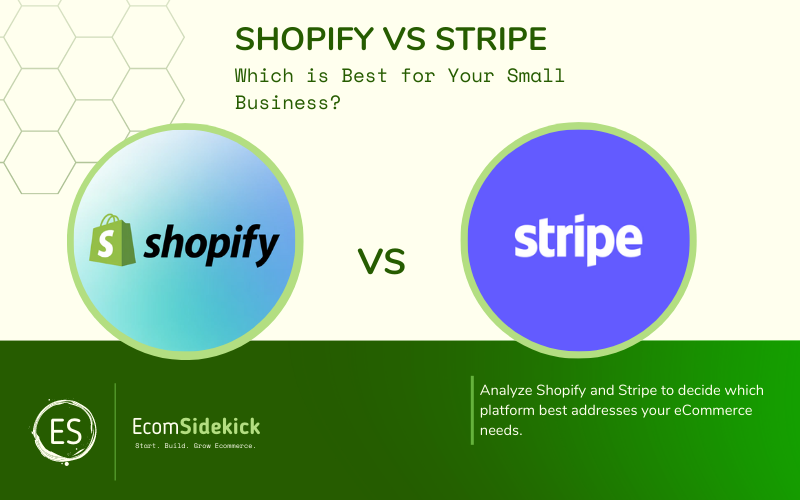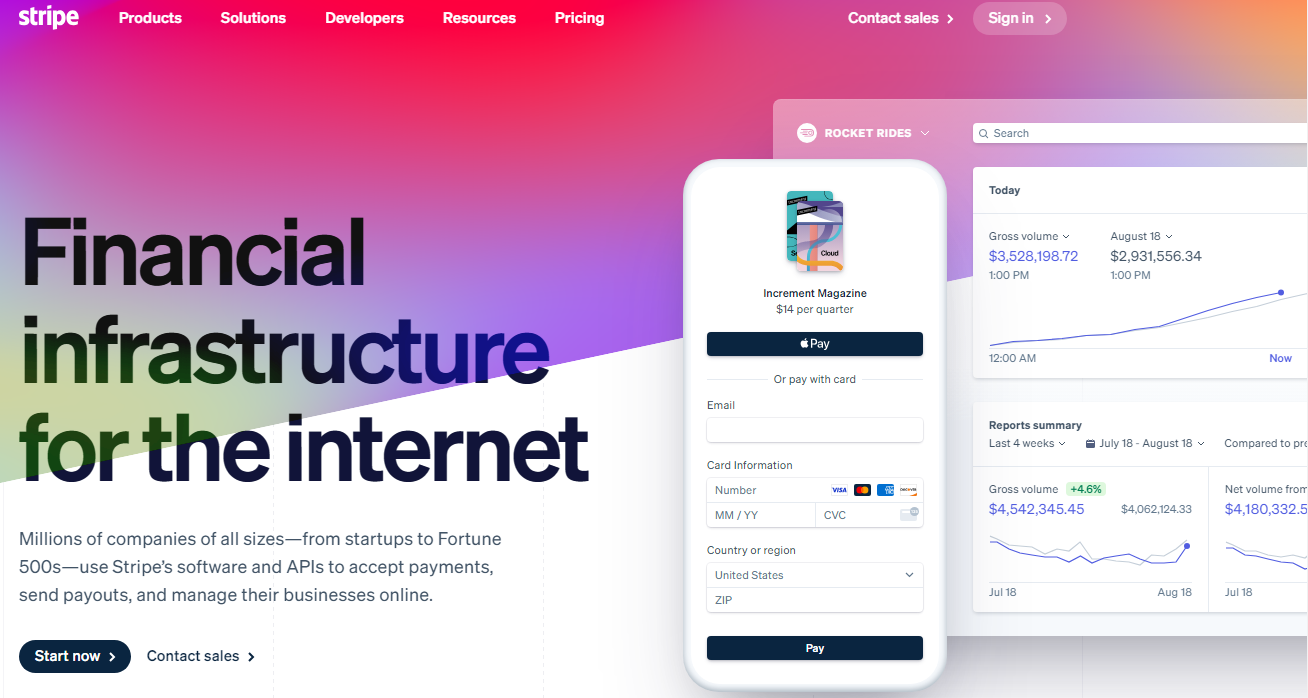It is no understatement to say that these two brands are some of the best platforms for online payments. Although Stripe and Shopify are all tools for that make it easier to start online businesses, these platforms have inherently different products.
Since these two brands offer relatively different services, it becomes difficult for a wholesome comparison. However, we can still compare the two brands based on their proprietary payment services. Both platforms allow you to accept and process payments online based on their payment processing capabilities.

While the two brands offer various features for customer payments, choosing one over the other at first glance is quite challenging. We will discuss the Shopify vs Stripe comparison regarding multiple features to help you understand the best brand.
About Stripe
Stripe is a payment service provider specially designed for small businesses to accept payments. These small businesses can also process payments using Stripe online payment processor.
Features

- Payment Methods: The brand allows small businesses to use different payment methods like ACH direct debit, debit cards, credit cards, and digital wallets.
- Pre-built Payment Solution: Stripe has customizable and pre-built payment solutions that make in-person payments more stressful and time-consuming.
- Tools Personalization: With Stripe, your online business takes a new turn since you can access many developer-friendly tools that afford you the highest level of personalization. Interestingly, you can manage your online invoicing and make local and integral payments without stress.
- Stripe Terminal: While Stripe is made for online payments, you can also enjoy the company’s Stripe Terminal, which allows you to have a point-of-sale for in-person payments. This feature is good if you like to go old school while running your business. With Stripe, you can accept payments in person and take care of any recurring transaction with a single click.
Pros
Many payment methods
Excellent checkout page
Easy-to-understand payment gateway
Transparent pricing
Good payment provider
24/7 customer payments platform
Supports international card payments
Fast process customer payments
Create an account in minutes
CONS
Tech-focused
Limited functions for in-person payments
About Shopify

Shopify, unlike Stripe, is an e-commerce platform that lets customers create and maintain their own custom online store.
The brand offers its users the ability to create, modify, customize, and manage their online store.
Features
- Cataloging: You can manage your online store by listing products for sale, completing orders, and taking payments.
- Multiple subscription Plans: Shopify has four subscription plans to help everybody enjoy the online experience. The platform also has enterprise-level solutions, including access to Shopify payments.
- Payment Options: Shopify Payments service allows users to access and process payments, either online or in person. Additionally, the brand has more than 100 payment providers integrated into its eCommerce store. However, Shopify charges a maximum fee if you use a third-party provider on the online payment platform.
Pros
Shopify integration
Quick and easy Shopify account setup
Supports local payment methods
Easy access to the Shopify store
Supports local and international payments
24/7 customer support
Excellent eCommerce platform
Fast payment processor
CONS
Limited availability
Additional transaction fees
Similarities Between Shopify vs Stripe
- Structure
Shopify and Stripe have almost similar pricing structures. Stripe does not charge transaction fees for its standard monthly payments platform. On the other hand, Shopify will not charge an extra monthly fee for using Shopify Payments. However, the brand will charge an additional fee for your monthly subscription.
Stripe charges 2.9% and 30 cents on each transaction for online payments made with credit or debit cards. Additionally, the brand will charge 0.8% per transaction. However, the good news is that they will never charge you more than $5 for bank debits or transfers. The brand also has other transaction fees, and Shopify charges its transaction fees based on the plan.
Shopify will charge 5% per transaction made on online payments and an extra 5% transaction fee for in-person payments. Additionally, the brand will charge 2.9 (0.30) per transaction for online payments. Also, the brand will charge 2.7% per transaction for in-person transactions. These rates are only for the Shopify Basic Plan, and the brand has different rates for the Shopify and Advanced Shopify plans.
- Payment Options
Stripe accepts several payment processing methods. The brand uses credit and debit cards like American Express, VISA, MasterCard, Discover, Diners Club, and Discover. Additionally, Stripe works with digital wallets like Google Pay, Apple Pay, Microsoft Pay, and WeChat Pay.
Also, the Shopify platform accepts debit and credit cards from American Express, VISA, JCB, MasterCard, Elo, Discover, and Diners Club. The brand also supports payments for digital wallets like Facebook Pay, Apple Pay, Google Pay, and Amazon Pay. Alternatively, you could use PayPal for your expenses.
Differences Between Shopify and Stripe
- Payment Method
You can also leverage Stripe’s ACH direct debit, wire transfers, and ACD credit transactions. Stripe also allows Buy Now, Pay Later (BNPL) payment options like Klarna and Afterpay. Alternatively, you could leverage the brand’s local and international payment methods. Stripe offers services in more than 30 countries with payment processing features in over 135 global currencies.
Shopify has several payment methods in 17 countries and regions, less than the 30 countries boasted by Stripe. However, both brands support payments in more than 130 currencies.
Unlike Stripe, Shopify does not accept ACH credit for business financing.
Also, with Shopify, you can process payments using local international payment methods. You could use Money Order, bank transfers, or cash on delivery options if you prefer manual payments. The manual payment method offers customers more leverage to shop with ease. Note, however, that Shopify does not process manual payments. Hence, you may need to work with another provider to complete your manual payments.
- Payment Implementation
Stripe offers several integrated payment processing options. Thus, you can consistently offer your clients a top-tier checkout experience. With Stripe, you can use a custom payment or pre-built form integrated into your site. Additionally, you can create a page to accept payments via a shared link.
Stripe also features a point-of-sale Terminal to accept payments in person. Additionally, you can bill your customers using customized online invoicing that allows your customers to pay online. Another thing is that you could use pre-built payment options for an eCommerce business. Hence, Stripe has one of its users’ most decent integration systems.
On the other hand, Shopify automatically integrates its Shopify Payments into every Shopify subscription. However, to access and process payments from customers, you must activate and log into your Shopify Payments account.
You can accept payments via Shopify by customizing your checkout and then accepting payments from your online store. Alternatively, you could accept payments through other sales channels on Shopify, like Instagram and Facebook. If you have one, you could also embed a purchase link on your website, and then accept payments via Shopify.
Another option is to pair your Shopify with your android or iOS smart device to accept in-person payments. Shopify has a great integration system that works well for all online businesses.
- Sign-up
Stripe offers a free payment account online for intending customers. All you have to do is sign up to start accepting payments. The brand does not need banking or contact details for you to get an account with them. The brand creates a dedicated merchant account for you in minutes to help you receive payments.
Stripe has an automatic daily payout schedule. However, you can modify the payout to monthly, weekly, or manual payment methods. Note that Stripe does not charge you extra for closing your account. You can receive your funds within two business days when the service approves your payment.
You must sign up for Shopify payments before you can start using Shopify Payments. The brand has various subscription plans which you can renew monthly. Additionally, the platform does not charge an extra monthly fee for using Shopify Payments. You will also not pay transaction fees when you use Shopify Payments for shopping.
Shopify does not have excessive credit card processing fees like other brands. Hence, you can make credit card payments while patronizing the Shopify store. You will receive the payment in your bank account within 24 to 72 hours.
Shopify |
| |
Stripe |
|
Our Pick
The best platform depends on the needs of the user and the features they are looking out for. Notwithstanding, Stripe and Shopify have amazing features you can explore for your business. In this article, Stripe is our pick due to its many features.
Conclusion

We have considered several things in the Stripe vs. Shopify comparison. It is fair to say that both brands offer outstanding services compared to others on the market. Shopify Payments is the ideal solution for businesses using Shopify. Shopify Payments is perfect because it is affordable and easy to use. However, you must ensure that Shopify Payments is available in your location.
Also, note that Shopify payments only apply to businesses on the Shopify platform. Once you have set up your payment details, you will find that the platform is an ideal online payment solution. However, Shopify does not work well as a third-party provider. Stripe is the better option for online payment processing. The brand has a highly adaptable setup with developer-friendly tools.
If you don’t have Shopify Payments in your location, Stripe is the best platform to consider. Stripe is one of the most customizable online payment solutions you will find. Hence, you can rely on Stripe to get your business going. So, which of these platforms is better? You can pick any of these platforms and enjoy the best out of them.
Frequently Asked Questions
What Is Shopify, and How Does It Compare to Stripe?
Shopify and Stripe are both popular e-commerce tools, but they serve different purposes. Shopify is an e-commerce platform that allows businesses to create and manage online stores, while Stripe is a payment processing platform that enables businesses to accept payments securely.
Which Platform Is More Suitable for Businesses Looking To Set up an Online Store?
Shopify is designed specifically for businesses wanting to create and manage their online stores. It provides a user-friendly interface and a range of features, making it a suitable choice for e-commerce beginners.
Can Shopify and Stripe Be Used Together for an Online Store’s Payment Processing?
Yes, Shopify and Stripe can be integrated seamlessly to handle payment processing on a Shopify store. Stripe is one of the available payment gateways that Shopify supports.
How Do the Costs and Fees Differ Between Shopify and Stripe?
Shopify has its pricing plans that include transaction fees, and additional fees may apply for using third-party payment gateways like Stripe. Stripe charges transaction fees based on the type of payment processed.
Can I Use Stripe as a Payment Processor on Platforms Other Than Shopify?
Yes, Stripe is a versatile payment processor that can be integrated into various websites and platforms, not limited to Shopify. Many online businesses use Stripe to accept payments on their websites.
Paul Martinez is the founder of EcomSidekick.com. He is an expert in the areas of finance, real estate, eCommerce, traffic and conversion.
Join him on EcomSidekick.com to learn how to improve your financial life and excel in these areas. Before starting this media site, Paul built from scratch and managed two multi-million dollar companies. One in the real estate sector and one in the eCommerce sector.



